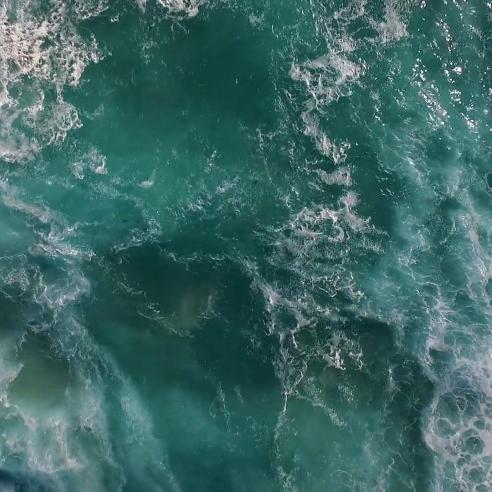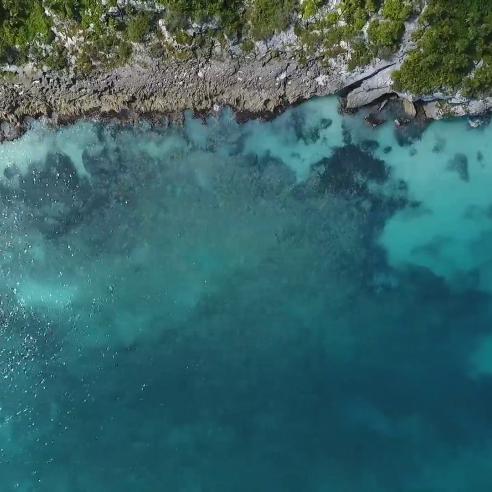Behind the data: algae as sentinels of change
These sensitive organisms respond to variations in an ecosystem
On the occasion of the 2025 UN Ocean Conference in Nice, France, EUMETSAT’s Dr Thomas Jackson explains how to identify algae in the ocean using satellite images.
A strong algal bloom
“In Figure 1, these images from late June 2024 highlight a big algal bloom in the southeast region of the North Sea, where we've got some open ocean and then the coast of Denmark.
“The left image shows the ocean colour as you would see from the point of view of the satellite in orbit. So, it’s the colour of the ocean plus the effect on the ocean colour by the atmosphere. And then in the right image, we have a derived product, in which the effect of the atmosphere on the ocean colour has been removed, making this image more representative of the colour you would see at the ocean surface.
“On the left side of the image on the left, we can see obviously there's a lot of blue, from the water itself, but as we move to the right, you can see some variation in that. There are two things we picked out: one is a pale blue area on the left side of the image and the other is a greenish area on the right side of the image
“So, the pale section on the left, labelled as coccolithophores, is a group of phytoplankton that make liths, little armored plates around their cells. When they start to bloom in large numbers, they can also shed these liths into the water. You end up with this milky colour because light scatters off the liths, reflecting white light. It's not an anomaly to see coccolithophores growing here, but this is quite a strong bloom, which is why we're seeing these really pronounced features.
“Then in the image on the right, we've got a different kind of phytoplankton bloom, a green one. The chlorophyll in these phytoplankton is absorbing the red light and the blue light, leaving the green light to be reflected. That’s why we have this green colour.”


Figure 1: On 26 and 27 June 2024, a variety of algae can be seen in the North Sea
Credit: Ben Loveday
Teasing out the components
"In Figure 2, we can see the chlorophyll concentration on the left side and suspended matter on the right in the same geographic area. The chlorophyll concentration has been estimated using a neural network approach. We have trained a neural network model, where you input the colour of the water in the form of the reflectance of that water at different wavelengths. Then, the neural network estimates which chlorophyll concentration corresponds to that spectral shape and colour intensity, basically. So in the image on the left side, we've got the chlorophyll, in the image on the right side, we have suspended matter.”
“When we’re looking at the optical properties of any body of water, you can think about it in terms of the two main processes: absorption and scattering. Phytoplankton with chlorophyll might absorb red or blue light. And those coccolithophores in the previous image tend to scatter the light. They have chlorophyll that's absorbing, but they also have these plates that scatter the light.
“Suspended matter has its own spectral characteristics – it also has absorbing and scattering properties. Usually, sediment, a type of suspended matter, is quite scattering, so it tends to make water appear brighter. It can also have a coloured component. If you look at, say, sediment in the Bristol channel, it has a very red colour because of the rocks around that region, whereas sediments in other regions can be much more yellow.
“In general, the biggest impact sediments have on the optics is the scattering. So, on the right side, we have an estimate of the amount of suspended matter, which contains a lot of sediment as well as other detrital materials floating in the water.
“Whenever we have these observations of the ocean and we're trying to work out what's contained within that water, there's often more than one thing in the water having an effect. Chlorophyll in algae is a big one but there are other components, too. You can have what they call colour dissolved organic matter which is not particulates but a kind of colouring of the water like tea.
“When we're trying to work out what's causing the optical signal that we see, we basically have to tease out all of the different components. When we estimate chlorophyll, we also want to estimate what other things might be affecting the optical signal so we know we've assigned the right concentration to each component.
“For example, imagine you have water that’s green because you put green dye in it. You could also turn the water green by putting in some dye that's blue and some that's yellow. In one case you've added one thing, in one case you've added two. They both give you a green colour because, in subtractive colour mixing, blue and yellow make green. So it's tricky. We try to identify all the different components in the water, so that we know the whole system rather than just one component.”


Figure 2: Different components in the water scatter light differently, making it possible to identify algae as well as suspended matter
Credit: Ben Loveday
Algal response to climate change
“With more ocean warming, the timing of these algal blooms may shift because the surface ocean stratifies earlier in the year. Or, if there are large-scale changes in weather patterns, for example, if the jet stream shifts slightly and you have prolonged periods of wind causing lots of wave action and ocean mixing, blooms may then be pushed to later into the year.
“So, there are mechanisms for the algae to respond to changing temperatures or climate. There are a number of scientific papers in which algae are referred to as sentinels of change because they are very sensitive to nutrient and temperature conditions.
“We are starting to see more studies looking at algae as indicators of climate change, but it's hard to definitively say at the minute, whether or not any one particular algal bloom is an effect of climate change.
“What we can definitely say from modeling exercises and our understanding of algae physiology, though, is that if you change the way the water is stratified, if you change regional mixing, if you change wind patterns, algae will respond.”
Are you an expert wanting to know more?
Check out the case study where you can find the accompanying Jupyter notebook.
Author:
Sarah Puschmann


